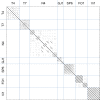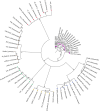A major-capsid-protein-based multiplex PCR assay for rapid identification of selected virulent bacteriophage types
- PMID: 30673846
- PMCID: PMC6394723
- DOI: 10.1007/s00705-019-04148-6
A major-capsid-protein-based multiplex PCR assay for rapid identification of selected virulent bacteriophage types
Abstract
Bacteriophages represent a promising alternative for controlling pathogenic bacteria. They are ubiquitous in the environment, and their isolation is usually simple and fast. However, not every phage is suitable for biocontrol applications. It must be virulent (i.e., strictly lytic), non-transducing, and safe. We have developed a method for identifying selected types of virulent phages at an early stage of the isolation process to simplify the search for suitable candidates. Using the major capsid protein (MCP) as a phylogenetic marker, we designed degenerate primers for the identification of Felix O1-, GJ1-, N4-, SP6-, T4-, T7-, and Vi1-like phages in multiplex PCR setups with single phage plaques as templates. Performance of the MCP PCR assay was evaluated with a set of 26 well-characterized phages. Neither false-positive nor false-negative results were obtained. In addition, 154 phages from enrichment cultures from various environmental samples were subjected to MCP PCR analysis. Eight of them, specific for Salmonella enterica, Escherichia coli, or Erwinia amylovora, belonged to one of the selected phage types. Their PCR-based identification was successfully confirmed by pulsed-field gel electrophoresis of the phage genomes, electron microscopy, and sequencing of the amplified mcp gene fragment. The MCP PCR assay was shown to be a simple method for preliminary assignment of new phages to a certain group and thus to identify candidates for biocontrol immediately after their isolation. Given that sufficient sequence data are available, this method can be extended to any phage group of interest.
Conflict of interest statement
Conflict of interest
The authors declare that they have no conflict of interest.
Research involving human participants and animals
Human participants and animals were not involved in this research.
Ethical standards
This research complies with the ethical standards of “Archives of Virology”.
Figures


Similar articles
-
Novel virulent and broad-host-range Erwinia amylovora bacteriophages reveal a high degree of mosaicism and a relationship to Enterobacteriaceae phages.Appl Environ Microbiol. 2011 Sep;77(17):5945-54. doi: 10.1128/AEM.03022-10. Epub 2011 Jul 15. Appl Environ Microbiol. 2011. PMID: 21764969 Free PMC article.
-
Host Range of Bacteriophages Against a World-Wide Collection of Erwinia amylovora Determined Using a Quantitative PCR Assay.Viruses. 2019 Oct 1;11(10):910. doi: 10.3390/v11100910. Viruses. 2019. PMID: 31581574 Free PMC article.
-
Programming virulent bacteriophages by developing a multiplex genome engineering method.mBio. 2025 Jun 11;16(6):e0358224. doi: 10.1128/mbio.03582-24. Epub 2025 May 23. mBio. 2025. PMID: 40407328 Free PMC article.
-
Origin, Evolution and Diversity of φ29-like Phages-Review and Bioinformatic Analysis.Int J Mol Sci. 2024 Oct 9;25(19):10838. doi: 10.3390/ijms251910838. Int J Mol Sci. 2024. PMID: 39409167 Free PMC article. Review.
-
Bacteriophage-encoded bacterial virulence factors and phage-pathogenicity island interactions.Adv Virus Res. 2012;82:91-118. doi: 10.1016/B978-0-12-394621-8.00014-5. Adv Virus Res. 2012. PMID: 22420852 Review.
Cited by
-
Klebsiella virus UPM2146 lyses multiple drug-resistant Klebsiella pneumoniae in vitro and in vivo.PLoS One. 2021 Jan 8;16(1):e0245354. doi: 10.1371/journal.pone.0245354. eCollection 2021. PLoS One. 2021. PMID: 33418559 Free PMC article.
-
Uncovering the determinants of model Escherichia coli strain C600 susceptibility and resistance to lytic T4-like and T7-like phage.Virus Res. 2023 Feb;325:199048. doi: 10.1016/j.virusres.2023.199048. Epub 2023 Jan 18. Virus Res. 2023. PMID: 36681192 Free PMC article.
-
Genomic characterization of three bacteriophages infecting donkey-derived Escherichia coli.Virus Genes. 2023 Oct;59(5):752-762. doi: 10.1007/s11262-023-02008-9. Epub 2023 Jun 15. Virus Genes. 2023. PMID: 37322310
-
Gene sequencing analysis of tailed phages identified diverse (Kayfunavirus and Berlinvirus) coliphages in aquatic niche against AMR Escherichia coli.Arch Microbiol. 2022 Jun 26;204(7):429. doi: 10.1007/s00203-022-03055-w. Arch Microbiol. 2022. PMID: 35753005
-
PCR Assay for Rapid Taxonomic Differentiation of Virulent Staphylococcus aureus and Klebsiella pneumoniae Bacteriophages.Int J Mol Sci. 2023 Feb 24;24(5):4483. doi: 10.3390/ijms24054483. Int J Mol Sci. 2023. PMID: 36901913 Free PMC article.
References
Publication types
MeSH terms
Substances
Grants and funding
LinkOut - more resources
Full Text Sources
Other Literature Sources
Miscellaneous

